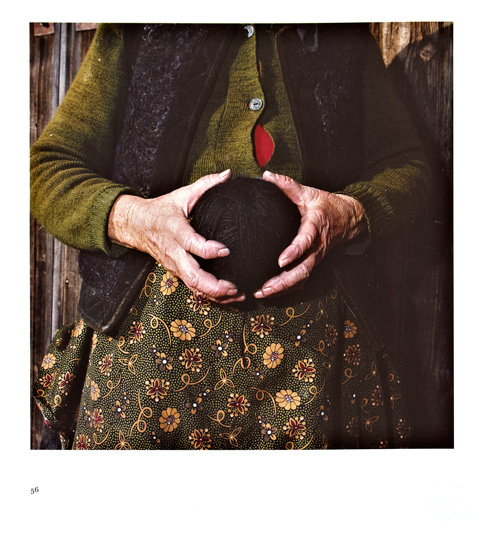| SIMON DENISON IMAGE & TEXT |
| PREVIOUS | NEXT |
TESSA BUNNEY: HAND TO MOUTH Impressions, Bradford
Tessa Bunney has built her reputation on the sympathetic documentation of rural life in Britain, especially Yorkshire where she lives. Her new show and book Hand to Mouth sees a continuation of these rural interests but this time in an altogether less familiar location, the Carpathian mountains of Romania. Here the age-old practice of transhumance survives, in which flocks of sheep are taken to upland pastures in summer and returned to the valleys in winter. Shepherds in voluminous sheepskin cloaks sleep in portable cabins out in the mountains. Skinned animals hang from poles in the open air. Down in the valleys, hay is pitchforked up into conical haystacks and sheep’s milk cheese is mashed and shaped by hand. The villagers grow enough food to survive and no more. This traditional and – judging by the visitors’ book at Impressions Gallery – to many people idyllic-sounding way of life is now threatened by food-industry health and safety regulations following Romania’s entry to the EU this year. Young people in the region have now largely abandoned farming and their parents’ hand-to-mouth existence to take advantage of Europe’s open borders and free markets. Almost all Bunney’s subjects are late middle-aged or elderly. We are therefore looking at a colourful European folk culture in critical danger of extinction through outside forces. This news story was not the driving force behind Hand to Mouth, which began long before Romania’s entry to the EU, but it adds a retrospective poignancy to the work. Bunney was first drawn to photograph the area by the lure of the exotic – a Radio 4 programme spoke of nomadic shepherds threatened by wolves and bears – and she has collected a two-dimensional folk museum of the area for us, full of shapely tools and utensils, vernacular hilltop and roadside structures, local customs, local produce, home furnishings and, above all, articles of clothing. These photographs include no meditations on transience and loss; instead they are made in Bunney’s distinctive style, graphically composed, close-focused, radically cropped and filled edge-to-edge with saturated blocks of colour. The use of flash in many of the images adds to the flattening effect, and the arrangement of colour forms is beguiling. Bunney is attracted to shape, texture and colour, and she weaves these elements into compositions that are greater than the sum of their various delightful parts. Sterner documentary photographers might object that events are rarely depicted, and that her pictures tell us very little about these peasants’ lives; about their character as people, for example; or what they believe in; or how they interact socially; or how they spend their hours of leisure. Instead we have a series of enigmatic Dijkstraesque portraits and a predominance of waist-level close-ups of hands holding foodstuffs and other items. It is the perfect match of equipment to subject: the 6x6 camera with waist-level finder used again and again to photograph people’s waists. There is wisdom, however, in Bunney’s method, for photography can never describe a life, it can only offer fragmentary and suggestive clues. Bunney’s fragments give us a shock of colour, and describe the surfaces of things, a collection of floral-patterned aprons and skirts, tactile knitwear and fresh veg thrust into the camera lens. You have to admire Bunney’s ability to get so close to strangers, to crouch below them or loom above them as they work in order to make her unconventional close-cropped images. This approach, developed through earlier work such as Upshoots, Lamb and Moor and Dale, is often instantly recognisable, and it is to her great credit that she has achieved that elusive photographers’ goal, a singular photographic style. Premonitions of the changes coming to the area can be seen not only in a general shortage of young people but also in styles of dress. Two children are depicted in this series, a boy wearing a baseball cap and a young girl in jeans and trainers – although she also wears a white knitted top and sits plaiting flowers while her parents build a haystack behind her. She is not quite yet a clone of her contemporaries in the West. The poverty of the area’s consumer goods, as distinct from goods handmade or grown, is also telling. One youngish man helping to shoe a horse wears a sportswear top with a broken zip and only a safety pin as a fastener. Another’s radio casette player has a broken casette holder. We see nothing bought that is shiny and new. As the EU’s objections to Carpathian food-processing practices centre on work done by hand (milking, cheese-making, slaughtering) it seems fitting that so many of Bunney’s pictures focus on her subjects’ hands. One might mischievously point out that most of them have a full set of dirty fingernails, which gives pause for thought. Yet these hands provide a sympathetic portrait of a community; each pair distinctive, marked by hard physical labour but capable of great tenderness, as they gently offer up whatever they are holding to the camera. Most notable are those of a rheumatic elderly woman crocheting what looks like a black and white bag, her index finger holding the thread just blurring with slight movement. Seen so close, particularly in the enlarged exhibition print, these are soft, holdable hands, our mother’s or grandmother’s hands. It is a moving picture, a deeply loving portrait. Indeed this entire series of images could almost be seen as a paean to the usefulness and vigour of age, and Bunney – a descendent of Emerson and Strand in her desire to restore dignity to rural people – has delivered a reprimand to the ageism that suffuses our Western culture and will no doubt come to these mountain regions before long. |
 |
|---|---|